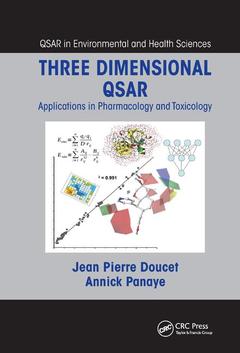Three Dimensional QSAR Applications in Pharmacology and Toxicology QSAR in Environmental and Health Sciences Series
Auteurs : Doucet Jean Pierre, Panaye Annick

As a result of new statistical and mathematical approaches, improved visualization tools, and recognition by international regulatory groups, quantitative structure-activity relationships (QSARs) now play important roles in pharmacology for the design of new drugs as well as in toxicology and ecotoxicology for hazard identification and risk assessment. Providing up-to-date coverage of the field, Three Dimensional QSAR: Applications in Pharmacology and Toxicology presents the most recent QSAR methods and illustrates their scope, advantages, and limitations.
Part IThe first part of the book addresses CoMFA and related methods, such as CoMSIA, FLUFF, SOMFA. It also describes shape-, surface-, and volume-based approaches, including MSA, excluded volume, LIV, HASL, receptor surface model, COMPASS, and CoMSA.
Part IIFocusing on methods that use 3D information, the second part covers autocorrelation methods, such as GRIND; similarity-based methods, including similarity matrices and quantum similarity indices; and quantitative spectroscopic data?activity relationships. Some applications in data mining are also explored.
Part IIIThe third part deals with post-3D models. The authors discuss the adaptation of the receptor and simultaneous presence of several conformers or solvation mechanisms.
Part IVThe final part presents receptor-related approaches as well as docking and free energy calculations, which are treated at various levels. This part concerns the extensive sampling of phase space and approximate methods, such as linear interaction energy, Poisson?Boltzmann, and generalized Born models. A case study covering several parallel approaches is also developed.
An appendix offers the basic principles of modeling and statistical tools routinely required in QSAR methodologies, includi
Actual 3D Models. Around the 3D Approaches. Beyond 3D. Receptor-Related Models. Concluding Remarks. Appendices. References. Index.
Jean Pierre Doucet and Annick Panaye are both professors at Université Denis-Diderot, Paris, France. They have chaired several conferences and published numerous papers.
Date de parution : 10-2019
15.6x23.4 cm
Date de parution : 12-2010
Ouvrage de 350 p.
15.6x23.4 cm
Disponible chez l'éditeur (délai d'approvisionnement : 15 jours).
Prix indicatif 256,94 €
Ajouter au panierThème de Three Dimensional QSAR :
Mots-clés :
QSAR Model; CoMFA; CoMSIA; PLS; PLS Analysis; Binding Modes; CoMSIA Model; Scoring Functions; CoMFA Analysis; Virtual Screening; Pharmacophore Model; CoMFA Contour Plot; Build QSAR Model; Whim; Structureactivity Relationship; Van Der Waals Surface; Active Conformation; CA Ii; hCA Ii; Autocorrelation Vector; HIV-1 Rt; NMR Shift; Lie Method; PLS Model; MD Simulation



